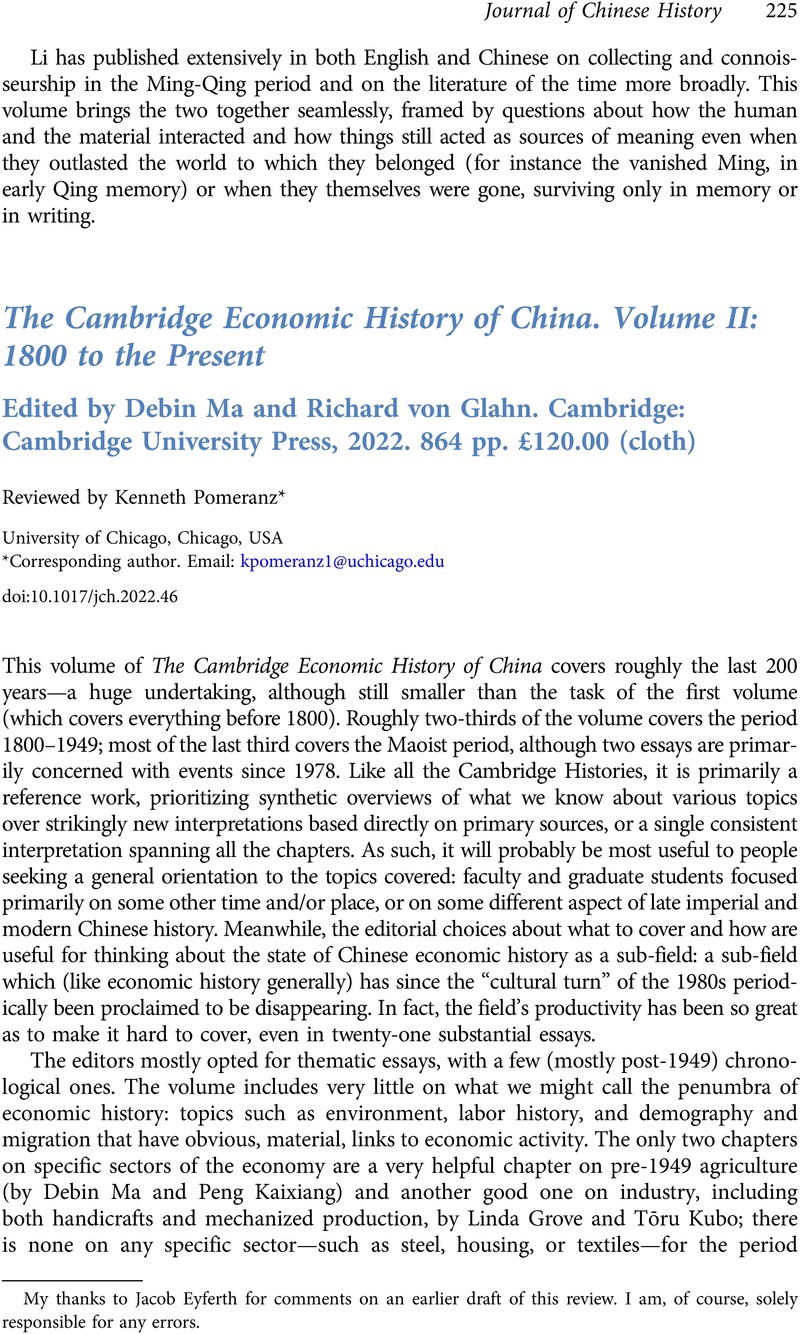No CrossRef data available.
Article contents
The Cambridge Economic History of China. Volume II: 1800 to the Present Edited by Debin Ma and Richard von Glahn. Cambridge: Cambridge University Press, 2022. 864 pp. £120.00 (cloth)
Review products
Published online by Cambridge University Press: 09 February 2023
Abstract

- Type
- Book Review
- Information
- Copyright
- Copyright © The Author(s), 2023. Published by Cambridge University Press
Footnotes
My thanks to Jacob Eyferth for comments on an earlier draft of this review. I am, of course, solely responsible for any errors.
References
1 The principle of comparative advantage holds that a country should specialize in those things in which it is most efficient relative to its potential trading partners. Thus, if country A can produce wheat at one third of the price that B can, and steel at half the price, it should import steel from B (even though it can produce that steel more cheaply), and divert the resources it would have used to make that steel into growing more wheat that it can sell to B. Arithmetic can show that—in a frictionless world of perfectly fungible resources—this makes both A and B better off. Note, however, that (in addition to other simplifications) this assumes a world in which A and B might go to war (so that both countries would want domestic sources of both steel and wheat), and that, in this simple version, comparative advantage ignores ways in which “learning by doing” might make a country more efficient at producing something in which it initially has a comparative disadvantage.
2 The bibliography here is almost endless, but I would particularly note Xia Mingfang's observation that the death toll from natural disasters alone in the last five (or in a different estimate, seven) decades of the Qing exceeded by more than ten times the total number for 1644–1796. See Mingfang, Xia, Minguo shiqi ziran hai yu xiangcun shehui (Beijing: Zhonghua shuju, 2000), 78–79Google Scholar, 400–402. Estimates for the death toll of the mid-century civil wars vary widely but were certainly in the tens of millions.
3 Like most scholars of inequality, Bramall uses the Gini coefficient to provide a single summary measure—one that aggregates all observed units and compares the distribution of income (or sometimes wealth) to a theoretical world in which every unit was exactly the same (yielding a Gini of 0.00) and to one in which a single unit got all the income (yielding a Gini of 1.00). In this case, that means that an “intra-urban” Gini collapses into one measure both the inequalities between, say, wealth and poor residents of Shanghai, and those between residents of Shanghai and those of, say, Shijiazhuang. At least until recent years, it was usually the case that inequalities within a single PRC city were fairly modest by international standards, while those between cities were often strikingly large. The same was true of inequalities within and between different rural communities. Urban versus rural inequality has, however, been consistently high. For a book that usefully disaggregates inequality within cities and between cities, though mostly for the period after Bramall's, see Feng, Wang, Boundaries and Categories: Rising Inequality in Post-Socialist Urban China (Stanford: Stanford University Press, 2008)Google Scholar.
4 See Chan, Kam Wing, Cities with Invisible Walls: Reinterpreting Urbanization in Post-1949 China (Hong Kong: Oxford University Press, 1994), 79Google Scholar, 83.
5 Sen, Amartya, Development as Freedom (Oxford: Oxford University Press, 2001), 181–82Google Scholar. Detailed studies of the famine are now quite numerous, and many highlight excessive grain requisitions and the resistance at high levels to reducing that extraction even as it became increasingly clear that people were dying. For one concise example, see Bernstein, Thomas, “Mao Zedong and the Famine of 1959–1960: A Study in Willfulness,” China Quarterly 186 (2006), 421–45CrossRefGoogle Scholar.
6 It is interesting that neither Naughton's essay nor Brandt and Rawski's pays much attention to TVEs, although both essays are otherwise admirably broad in their coverage of the reform era and both insist that the process of reform has been anything but linear. It is true that these firms did not become a lasting part of the Chinese landscape, but in the first fifteen years of reform they generated well over 100 million new jobs, playing a vital part in the linked phenomena of poverty reduction and moving much of the labor force out of agriculture. It may be that the sometimes awkward combination of entrepreneurship and local public ownership that they represented makes them hard to fit into any smooth narrative of “state” versus “market” driven growth, but for that very reason it would have been useful to see them discussed.
7 Rawski, Thomas, Economic Growth in Prewar China (Berkeley: University of California Press, 1989)Google Scholar.
8 Wolfgang Keller and Carol Shiue do, however, point to the likelihood of foreign-induced technological unemployment in a few places (446–47).
9 For just a few salient contributions in the last two years and focusing almost exclusively on the supposedly backward North China interior, see Matthew Lowenstein, “Financial Markets in Late Imperial China, 1820–1911” (Ph.D. diss., University of Chicago, 2021); Wang, Luman, Chinese Hinterland Capitalism and Shanxi Piaohao: Banking, State, and Family, 1720–1910 (London: Routledge, 2021)Google Scholar; Shuji, Cao and Junsong, Xu, “Qingdai Shanxi de qiantie yu xinyong: yu Dongnan diqu bijiao,” Shilin 6 (2020), 79–95Google Scholar; Junsong, Xu and Shuji, Cao, “Qingdai Shanxi qiantie: fenlei, qiyuan, yu xinyong,” Shehui kexue 7 (2021), 155–66Google Scholar.
10 For one version of such an analysis, see Hung, Ho-fung, “Rise of China and the Global Over-Accumulation Crisis,” Review of International Political Economy 15.2 (2008), 149–79CrossRefGoogle Scholar.



